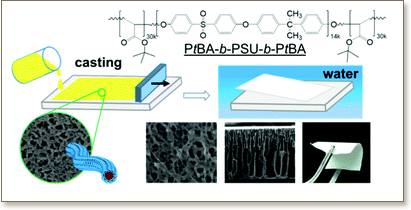Synthesis of highly porous poly(tert-butylacrylate)-b-polysulfone-b-poly(tert-butyl acrylate)asymmetric membranes
Y. Xie, N. Moreno, V.M. Calo, H. Cheng, P.-Y. Hong, R. Sougrat, Ali R. Behzad, R. Tayouo, S.P. Nunes
Polym. Chem., Advance Article, (2016)
DOI: 10.1039/C6PY00215C

For the first time, self-assembly and non-solvent induced phase separation was applied to polysulfone-based linear block copolymers, reaching mechanical stability much higher than other block copolymer membranes used in this method, which were mainly based on polystyrene blocks. Poly(tert-butyl acrylate)-b-polysulfone-b-poly(tert-butyl acrylate) (PtBA30k-b-PSU14k-b-PtBA30k) with a low polydispersity of 1.4 was synthesized by combining step-growth condensation and RAFT polymerization. Various advanced electron microscopies revealed that PtBA30k-b-PSU14k-b-PtBA30k assembles into worm-like cylindrical micelles in DMAc and adopts a “flower-like” arrangement with the PSU central block forming the shell. Computational modeling described the mechanism of micelle formation and morphological transition. Asymmetric nanostructured membranes were obtained with a highly porous interconnected skin layer and a sublayer with finger-like macrovoids. Ultrafiltration tests confirmed a water permeance of 555 L m−2 h−1 bar−1 with a molecular weight cut-off of 28 kg mol−1. PtBA segments on the membrane surface were then hydrolyzed and complexed with metals, leading to cross-linking and enhancement of antibacterial capability.